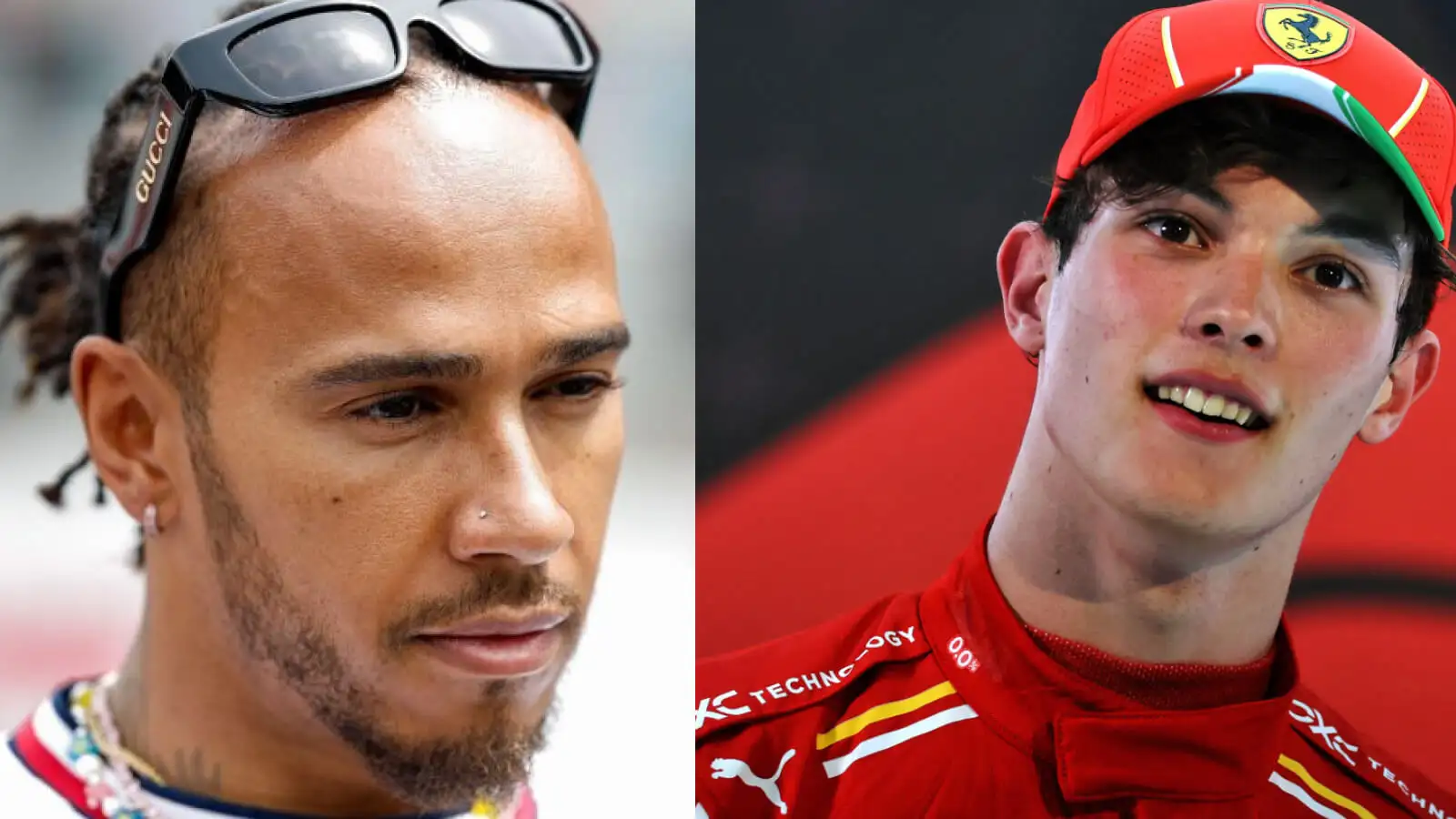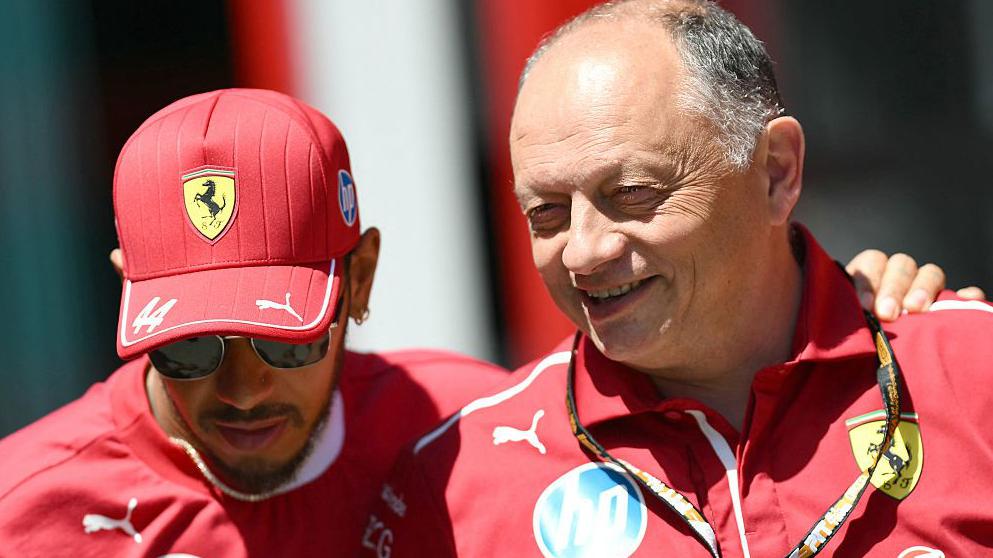The narrative surrounding Formula 1 is often a dramatic interplay between proven champions and ambitious youth, but rarely has that dynamic presented a team with a decision as fraught with consequence as the one now facing Ferrari.
The team’s future, already secured with the blockbuster signing of seven-time world champion Lewis Hamilton, has been thrown into an unexpected state of flux by the blistering, measured performance of their 20-year-old prodigy, Ollie Bearman.
His masterful drive in the Mexican Grand Prix wasn’t just a highlight of his rookie season; it was the moment Bearman transformed from a future possibility into an immediate, unsettling question mark hovering over the Scuderia’s biggest investment.
The core message echoing through the Maranello halls, and now reverberating across the F1 punditry landscape, is that Lewis Hamilton’s arrival—a monumental decision in terms of both legacy and expenditure—is now being shadowed by the uncomfortable reality of a youthful successor who may be ready sooner than anyone anticipated.

The Rise of a Prodigy: Bearman’s Breakthrough
Ollie Bearman’s trajectory has been one of immense promise, tempered by the kind of inconsistency common in a rookie season. He has been part of the Ferrari driver academy, clearly marked for a future in red. His spectacular stand-in performance at the Saudi Arabian Grand Prix had already shown his immense raw potential, but his rookie year in F1 has been a mix of blinding speed and occasional erratic errors.
The Mexican Grand Prix, however, served as a crucial turning point. It was a “measured performance” that demonstrated maturity and control, arriving at precisely the moment team principal Fred Vasseur—who is already “very much on his side”—needed it. As analysts noted, this was the “peak of what both Bearman and the team had been hinting at all year,” executing a race with clean precision and securing the best possible result, far removed from previous instances of unnecessary spins or errors.
At just 20 years old, Bearman now finds himself at the confluence of talent, timing, and tremendous pressure. He is currently learning his trade at Haas, a period analysts suggest is “the perfect team for him” to sharpen his skills and gain consistency, a necessary step before making the jump to a top-tier team.
The Uncomfortable Truth About Hamilton’s Future
The crucial element of the Bearman story is its direct collision with the Lewis Hamilton narrative. As pundits debate, Bearman’s most likely route into the coveted Ferrari seat is Lewis Hamilton calling it a day in Formula 1. However, the rising pace of the young Brit is now inspiring a more radical question: Should Ferrari be seriously considering putting Ollie Bearman in the car and benching Lewis entirely?
The underlying tension is the looming 2026 regulation change. If Ferrari is building a program for the future, especially one that spans the next five to six years, investing in a young driver like Bearman alongside Charles Leclerc makes strong, long-term strategic sense. Commentator Nelson Valkenburg posed the difficult question: “If it’s another season like he’s enduring now, what is the point of it also from Ferrari standpoint? You might as well invest in a driver that can go on for in the next 5-6 years and that won’t be Lewis because of the fact that the time just keeps on ticking.”
Hamilton is a colossal, multi-year investment, a move designed to secure an immediate competitive edge and provide experience. Yet, if his performance continues to hover just a fraction behind Leclerc—as it has recently—the benefit of that immense investment diminishes, making the high-potential, lower-cost option of Bearman an increasingly attractive piece of “insurance for the moment that [Leclerc] maybe moves on.”
The current situation is not the clear-cut, irresistible force of Charles Leclerc pushing out an overstayed Kimi Räikkönen. Hamilton has shown recent signs of improvement, bringing his performance to a “decent staging point for next year.” But the fact remains: if Bearman’s current upward trajectory continues, by the time the 2026 regulations hit, he will be compelling Ferrari to choose between a legendary but aging champion and a homegrown star who is undeniably ready to shine. The pressure on Hamilton is now very real; he’s not just fighting for his seat, but for the legacy of his move to the most storied team in the sport.

Contrasting Fortunes: Ferrari’s Dilemma vs. Red Bull’s Mess
The high-stakes, internal debate at Ferrari over Hamilton and Bearman gains sharper contrast when held up against the chaotic driver management at their rivals, Red Bull Racing. The Red Bull program—despite being the benchmark for performance—is in a state of self-admitted organizational disarray when it comes to the second seat.
The Mexican Grand Prix was supposed to be the deadline for Red Bull’s decision on their driver lineup, particularly regarding the fate of Yuki Tsunoda and the promotion of Isack Hadjar or Liam Lawson. Instead of a decisive conclusion, the team opted to “take more time.” The stated reason? Max Verstappen is unexpectedly in a title fight, and driver announcements could become a “distraction,” creating “noise” that jeopardizes their season goals.
The numbers tell a damning story: Yuki Tsunoda’s low points tally compared to Verstappen raises serious questions about his suitability as a number two driver who can provide strategic backup. While Tsunoda has shown flashes of good pace, his execution is still inconsistent, leaving Red Bull to wonder if his best is truly “good enough” for a team with championship aspirations.
The problem, however, is bigger than Tsunoda. Pundits were quick to label Red Bull’s constant indecision and revolving door of second drivers as “an absolute mess” and an “embarrassment” for an organization that excels in every other area. The continual churn—where a decision to drop a driver or announce a replacement creates instability that undermines the current season—is a function of a system that has been broken ever since Daniel Ricciardo left.
The Ferrari/Bearman situation, despite its complexity, follows a logical, if accelerated, driver-development path: nurture the talent (Bearman) in a lower team (Haas) to get him ready for the top seat. The Red Bull situation, by contrast, is a perpetual state of uncertainty, where young drivers like Hadjar and Lindblad are given high-pressure opportunities but the team never follows through with the patience required to let a succession plan truly work.
For Ferrari, the high-quality driver dilemma is: Who do we choose? For Red Bull, the agonizing low-quality driver dilemma is: Why can’t we find anyone who sticks?

Looking Ahead: The Generational Shift
The 2026 regulation change is the elephant in the F1 room, representing a full reset of the competitive order. For Hamilton, it offers the promise of a renewed chapter and a shot at an unprecedented eighth title with a fresh start. For Bearman, it represents the ideal opportunity to enter the sport with a completely new car, offering the kind of clean slate that minimizes a rookie’s typical disadvantages.
Ultimately, Bearman’s performances are rapidly closing the window of opportunity for Hamilton’s tenure to be defined solely by the champion’s own timeline. The rising star has already shown enough to be seriously considered for the coming seasons, if not earlier. As the analysis concluded, Bearman is in a better position than many other top rookies because he’s already fast enough; he just needs to prove his consistency.
Ollie Bearman is not just waiting for Lewis Hamilton to retire; his undeniable trajectory is actively forcing Ferrari to look at their “big investment” with a cold, strategic eye. The comfortable stability of a champion is facing the relentless challenge of youth, speed, and potential, creating a paradox at the heart of the sport’s most historic team. The decision Ferrari makes—whether to back the seven-time champion or fast-track the next generation—will be the one that defines the Scuderia for the next decade.